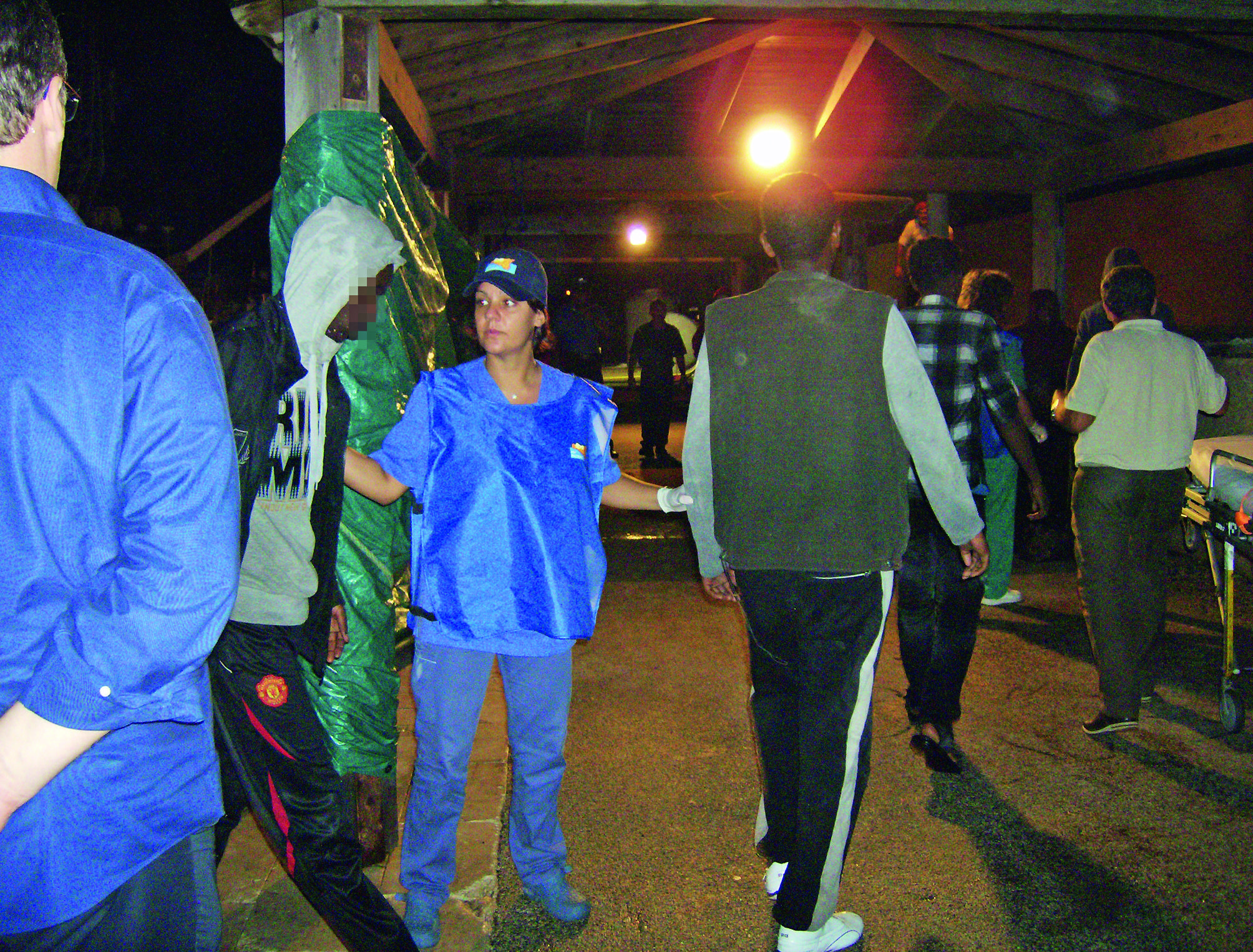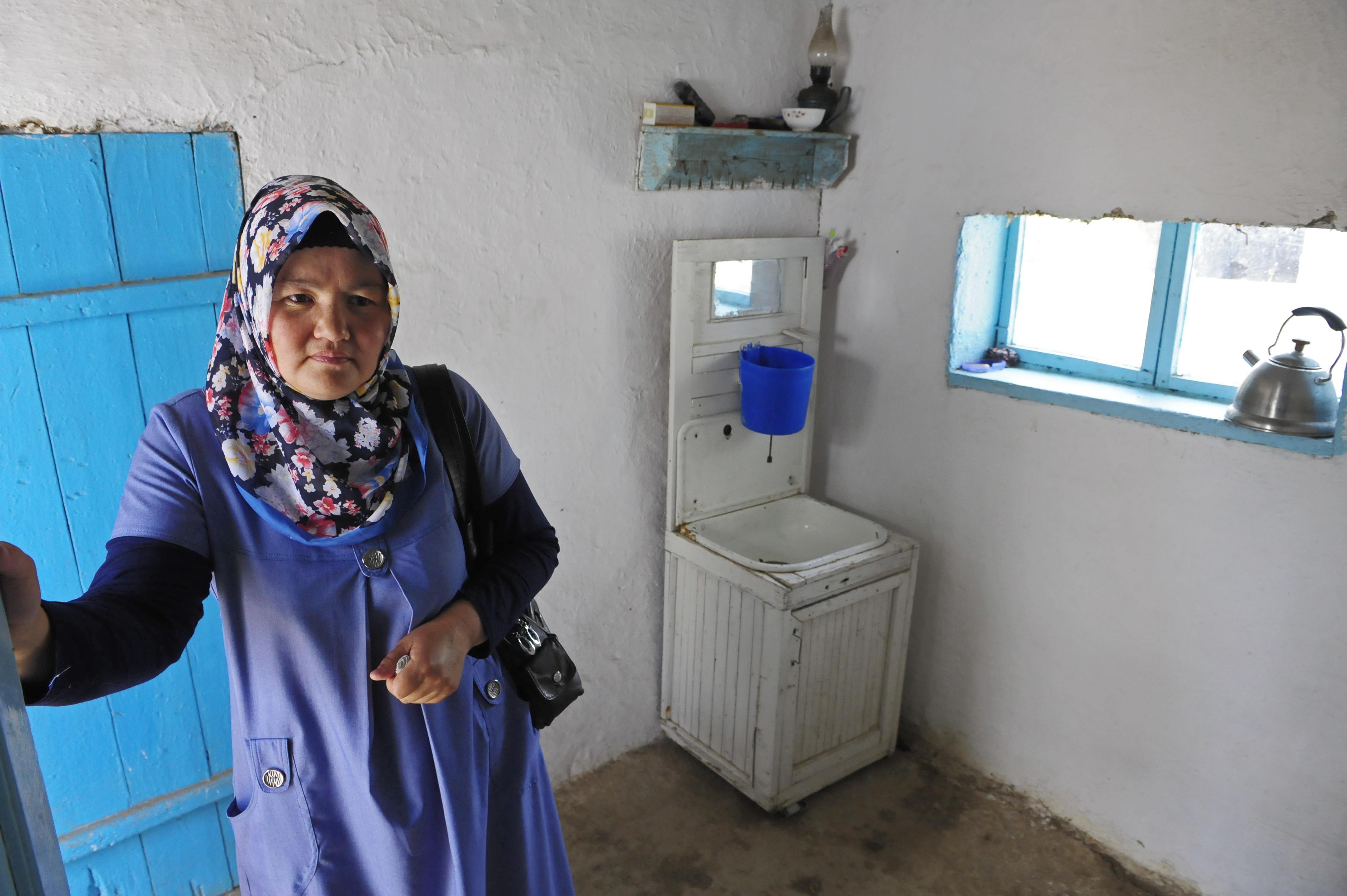Local health workers on the tiny Italian island of Lampedusa sort arriving migrants into groups according to whether they need first aid or other health care. Thousands of migrants have been arriving on the island from north Africa and the Middle East over the last decade. WHO's Regional Office for Europe is supporting the Italian health ministry by doing assessments of the Italian health system's preparedness for the influx.
WHO coordinates health relief after typhoon Haiyan
The World Health Organization (WHO) has been supporting the Government of the Philippines in coordinating the incoming relief supplies from more than 30 international humanitarian health organizations following Typhoon Haiyan on 8 November.
WHO Director-General Dr Margaret Chan declared the humanitarian situation in the Philippines a Grade-3 Emergency under WHO's Emergency Response Framework, thus placing Organization-wide resources at the disposal of the WHO head of office and the emergency support team that the Western Pacific Regional Office is establishing to assist with relief efforts.
An estimated 25% of the population of the Philippines, about 25 million people, have been affected and hundreds of thousands of people are displaced. Many are now struggling to survive without food, shelter or clean drinking water.
Health facilities were damaged or completely destroyed across large swathes of the affected regions, and, as a result of the breadth and severity of the storm, health services in the worst affected areas have ceased to exist or have been severely stretched, with medical supplies in very short supply.
WHO is working with the government to rapidly assess of the life-saving needs of the population in these areas.
“WHO is coordinating the health-related aspects of the response, for example, to avoid duplication of materials and medicines arriving at any one location and to get mobile field hospitals, health workers and medical supplies, which have been donated, to the places where they are needed most,” said Dr Julie Hall, WHO Representative to the Philippines.
Within three days of the typhoon hitting the Philippines, field hospitals with medical teams from Australia, Belgium, Germany, Israel, Japan and Norway had arrived. Other countries including Canada, Finland, Hungary, Indonesia, the Netherlands, New Zealand, Norway, Singapore, Spain, Switzerland, the United Kingdom, the United States of America and Viet Nam have also pledged their support.
Hall said that the health needs in this disaster were significant given that, in addition to injuries and trauma, there were routine health needs in the affected areas, including people with noncommunicable diseases such as diabetes or heart disease who needed to continue receiving their regular medication.
Within days after disaster struck, WHO had deployed medicines and supplies to perform 400 surgeries and cover the basic health needs of 120 000 people for one month. Special diarrhoeal disease kits with medicines and supplies to treat 3000 cases of acute diarrhoea were also on their way to affected areas.
The United Nations has appealed for US$ 301 million in emergency aid to help millions of people who are affected.
Countries respond fast to polio outbreak
A mass vaccination campaign is planned this month targeting 22 million children across the Middle East following an outbreak of polio in the Syrian Arab Republic.
The campaign was part of a comprehensive outbreak response that was rolled out across the Middle East after 13 cases due to wild poliovirus type 1 (WPV1) in the country were confirmed last month.
In a joint resolution, all Member States in the WHO region declared polio eradication to be an ‘emergency'.
WHO and the United Nations Children's Fund (UNICEF) are coordinating the vaccination campaign with all concerned parties to make sure that all children are vaccinated no matter where they are located. It was launched in seven countries and territories: Egypt, Iraq, Jordan, Lebanon, the Syrian Arab Republic, southern Turkey and the West Bank and Gaza Strip.
Genetic sequencing indicates that the isolated viruses are most closely linked to viruses detected in environmental samples in Egypt in December 2012, which in turn had been linked to wild poliovirus circulating in Pakistan. Closely related wild poliovirus strains have also been detected in environmental samples in Israel, the West Bank and Gaza Strip since February 2013.
Pakistan, along with Afghanistan and Nigeria, are the three last remaining countries where polio is endemic.
The first priorities of the mass vaccination campaigns in the Syrian Arab Republic, where wild poliovirus has not been detected since 1999, are to resupply and reactivate the required health infrastructure, including redeploying health workers to deliver vaccine in the worst-affected areas, and moving vaccine across conflict lines where necessary and possible.
http://www.polioeradication.org; http://www.emro.who.int/media/news/vaccinating-20-million-children-syria.html
Global health worker shortage may get worse
The world faces an estimated shortfall of 7.2 million health workers, a gap that could become even worse and increase to 12.9 million by 2035 if nothing is done to address the problem soon, according to a new WHO report.
The report entitled A universal truth: no health without a workforce is an analysis of the latest data on health workforce availability, accessibility, acceptability and quality around the world and calls on countries to take action to reverse this looming crisis.
In the report, WHO recommends five key courses of action that countries should take: support long-term human resource development efforts; improve the quality of health workforce data and boost the role of mid-level and community health workers.
The current rate of training of new health professionals is falling well below current and projected demand, it warns. As a result the sick will find it harder to get the essential services they need and preventive services will suffer.
The report was released in Recife, Brazil, last month, at the Third Global Forum for Human Resources for Health.
A special issue of the Bulletin of the World Health Organization devoted to the topic of the health workforce for universal health coverage was also launched at the event.
http://www.who.int/workforcealliance/knowledge/resources/hrhreport2013
Kyrgyzstan, a low-income country in Central Asia, has one of the highest vaccination rates in the world, thanks to a well-organized system established when it was a Soviet republic in which midwives play a key role. This midwife is responsible for all routine vaccinations in her village of 6200 inhabitants in Kyrgyzstan's Jalal-Abad province.
Updated malaria vaccine roadmap launched
By 2030 the world should aim to have licensed vaccines that can reduce malaria cases by 75% and are capable of eliminating malaria, according to the updated 2013 Malaria Vaccine Technology Roadmap launched last month.
The new target comes in addition to the original 2006 roadmap's goal of having a licensed vaccine against Plasmodium falciparum malaria, the most deadly form of the disease, for children under 5 years of age in sub-Saharan Africa by 2015.
“Safe, effective, affordable vaccines could play a critical role in defeating malaria,” said Dr Robert D Newman, Director of WHO's Global Malaria Programme. “Despite all the recent progress countries have made, and despite important innovations in diagnostics, drugs and vector control, the global burden of malaria remains unacceptably high.”
WHO estimates that of 219 million people with malaria, some 660 000 die of the disease every year. The scale-up of WHO-recommended malaria control measures has been associated with a 26% reduction in the global malaria death toll over the last decade and effective malaria vaccines, if they can be successfully developed, could complement those measures.
WHO lists 27 malaria vaccine candidates currently in clinical trials, with most in early stages of testing.
Only one known as RTS,S/AS01 is in late-stage development and the final results from these Phase III trials will be available by 2015. Depending on these results and the outcome of the regulatory review by the European Medicines Agency, a WHO recommendation for use and subsequent prequalification of this first vaccine could follow in late 2015.
New family planning guide
A guide for health programme managers and policy-makers released last month aims to improve access to family planning for women after childbirth and during the first 12 months of motherhood.
Closely-spaced and unintended pregnancies are a health risk to both mother and child, according to the guide, while spacing pregnancies at least two years apart can avert about 10% of infant deaths and 1 in 5 deaths in children aged 1 to 4.
Launched at the International Conference on Family Planning in Addis Ababa, Ethiopia, Programming strategies for postpartum family planning provides interventions at all levels of health care to expand access to evidence-based family planning methods for new mothers.
The new publication was launched by WHO in collaboration with the US Agency for International Development and its implementing partner, the Maternal and Child Health Integrated Program.
http://www.usaid.gov/sites/default/files/documents/1864/postpartum_family_planning.pdf
1 December – World AIDS Dayhttp://www.who.int/campaigns/aids-day/2013/event
3 December – International Day of Disabled Persons
20–25 January – WHO Executive Board (EB134) meeting
27–31 January – Prince Mahidol Award Conference: Transformative Learning for Health Equity, Bangkok, Thailand. http://www.pmaconference.mahidol.ac.th/
30 January – World Leprosy Day
4 February – World Cancer Day

 WHO/Matteo Dembech
WHO/Matteo Dembech WHO/GAVI/Victoria Ivleva
WHO/GAVI/Victoria Ivleva